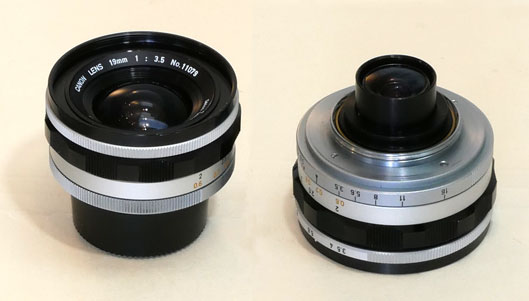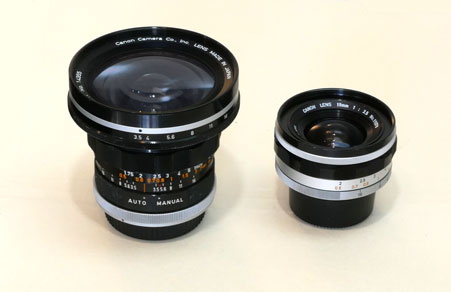Canon Rangefinder 19mm Lenses
A Description of Canon Rangefinder 19mm Lenses produced 1964

the excellent Canon 19mm f3.5 lens with finder
Canon 19mm f3.5 lens for Rangefinder Cameras
In August 1964, Canon introduced an 'extreme' lens - extreme in its ultra-wide focal length, and extreme in the sophistication of its design and quality of its images. This advanced design employed 9 elements in 7 groups, and is decribed in detail below.
Symmetrical Optical Design versus Retrofocus Design
Wide-angle lenses of 35mm rangefinder cameras usually used what is referred to as 'symmetrical optical design'. This formulation of wide-angle lenses was shown to produce reduced rectilinear distortion at the edges of the image. The Canon 19mm f3.5 lens of 9 elements in 7 groups was an advanced version of this type of design.

One of the consequences of the Canon 19mm f3.5 lens symmetrical design was that the the rear lens element projected deeply into the camera body. The distance between the rear element of the lens and the film plain was similar to the focal length of the lens.

Canon 19mm f3.5 lens front and back
Retrofocus Wide-Angle Design
The protrusion of the rear lens element of wide-angle lenses such as the Canon 19mm f3.5 made them unsuitable for use with single lens reflex cameras which needed room inside the camera body for the mirror movement. The single lens reflex camera could lock its mirror up so as not to hit the back of the wide-angle lens, but in that case, the photographer could not see the image being photographed.
The solution was to apply retrofocus lens design. This design is sometimes called 'inverted telephoto' design. It employs one or more negative lens groups at the front of the lens to increase the back focal distance of the lens. This back focal distance is the distance between the rear of the lens and the film plain. This design can provide a back focal distance which is greater than the (small) focal length of a wide-angle lens. In this way, a proper design will give sufficient room behind the lens for the single lens reflex mechanism to operate.
Early designs of retrofocus wide angle lenses for the single lens reflex had some very large negative lens groups at the front of the lens. Have a look, below, at the early Canon 19mm f3.5 retrofocus lens (in an FL mount) designed for the Canonflex camera of the early 1960s - compared with its very compact rangefinder cousin.

As advanced computer-aided design, rare glass elements, and eventually aspherical lens elements became available, wide-angle lenses for SLRs became much more compact, as well as becoming superior in the avoidance of the aberrations of older designs.
Success of the Canon 19mm f3.5
The Canon 19mm f3.5 lens continued in production 1964 until the end of Canon rangefinder lens production in 1974-1975. During this period, it sold 1,561 lenses - a good quantity for such a special-use lens. Even today, it is a respected lens on rangefinder cameras and even in some cases on modern digital bodies. However, the relatively small number of these lenses manufactured, and their consequent scarcity have resulted in collectors bidding up the price in secondary markets to very high levels. This has limited its use by practical photographers. Still, it remains 'a thing of beauty'.
You can click on the links in the table below to consult other pages of the canonrangfinder.org site.
| Navigation: Click Below to Jump to Desired Subject Page | ||
|---|---|---|
| Canon Rangefinder Cameras - 1 | Canon Rangefinder Cameras - 2 | Canon Rangefinder Lenses |
| Canon S | Canon IVSB2 | Canon 19mm |
| Canon J | Canon IIS2, IID2, IIF2 | Canon 25mm |
| Canon NS | Canon VT, Canon L2 | Canon 28mm |
| Canon JS | Canon L1, L3 | Canon 35mm |
| Canon J-II | Canon VT Deluxe | Nikkor 50mm |
| Canon S-II | Canon VL, VL2 | Canon 50mm |
| Canon IIB | Canon VI-L, VI-T | Canon 85mm |
| Canon III, IIC, IV | Canon P | Canon 100mm |
| Canon IIIA, IVF, IVS | Canon 7 | Canon 135mm |
| Canon IIA, IID, IID1 | Canon 7s | Canon 200mm-1000mm |
| Canon IVSB | Minolta Rangefinders | Minolta Lenses |
| Canon IIF, IIS | Other Rangefinders | other M39 lenses |
| Go to canonrangefinder.com home page | ||
Any additions or corrections to these pages would be welcome simply by contacting this site as shown at the foot of this page .
Footnotes:
1 Dechert, Peter. Canon Rangefinder Cameras 1933-1968. Hove Collectors Books. West Sussex, United Kingdom. 1985. ISBN 0-906447-30-5.
Peter Dechert's book is the most important expert source of information regarding Canon Rangefinder Cameras.
2 Kitchingman, Peter. Canon M39 Rangefinder Lenses 1939-1971. A Collector's Guide. Published by Peter Kitchingman. Perth, Australia. 2008. ISBN 978-0-646-48144-9.
Peter Kitchingman's book is the definitive study of the more than three decades of M39 format camera lenses developed for Canon Rangefinder Cameras.
3 Nostalgic Canon Camera Book. 懐かしいキヤノン EI Publishing Co. Ltd. Tokyo, Japan. June 2003.
Peter Kitchingman's book is the definitive study of the more than three decades of M39 format camera lenses developed for Canon Rangefinder Cameras.
4 "Canon Camera Museum" history website. https://global.canon/en/c-museum/history/ published by Canon, Inc. accessed in 2019.
5 Rajner, Hans P. (author), John Wade (editor). Leica Copies. Classic Collections Publications. London, UK. ISBN 13: 9781874485056
Hans P. Rajner's book is an excellently detailed and carefully researched study of camera from around the world which used the Leica M39 lens mount and the same lens to film plane distance.
7 Dechert, Peter. Canon Single Lens Reflex Cameras 1959-1991. Historical Camera Publications. Yakima, Washington. 1992. ISBN 1-879561-04-2.
8 Tomlinson, Shawn M. The Film Photography Book. Lulu Pulbications. 2016. ISBN: 9781365263972
9 Sartorius., Ghester. Identifying Leica Lenses. Classic Camera 19. Tokyo, Japan. 2001. ISBN 4-257-12029-0
10 website http://www.nicovandijk.net/rflensmatrix.htm consulted 2019.
11 O'Reagan, Douglas M. Allied Exploitation of German Science after World War II. Johns Hopkins University Press. Baltimore, Maryland. 2019. ISBN 9781421428888
12 website www.canonrangefinder.servehttp.com consulted 2008.
13 Minolta expert Andrea Aprà has posted information on minoltarangefinders group and other groups and further detailed information by email. (thanks Andrea !)
14 website http://www.collection-appareils.fr/objectifs/ consulted 2019.
15 Small, Marc James. Non-Leitz Leica Thread-Mount Lenses. Wittig Books. Hückelhoven, Germany. 1997. ISBN 3-930359-47-2.
16 the Nikon Corporation website: https://imaging.nikon.com/history/ consulted 2019.
17 p 152. Ray, Sidney F. Photographic Lens ISBN 9780240510323
18 website http://www.rokkorfiles.com/Lens%20History.html accessed 2019
If you have any comments or questions about this Canon Rangefinder site, please e-mail me (Larry Huffman) at e-mail address: [email protected]